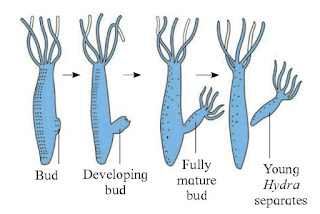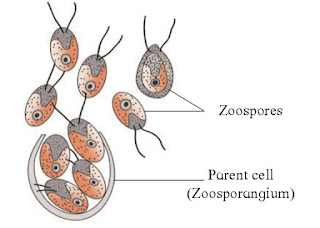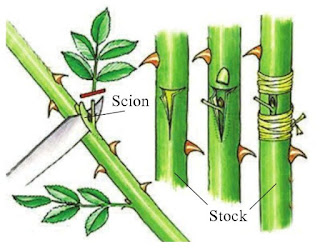What is Asexual Reproduction | Defination | Types of Asexual reproduction | Advantages
What is Asexual Reproduction | Definition | Types of Asexual reproduction | Advantages?
- Asexual reproduction is defined as the mode of reproduction which does not involve in fusion of two compatible gametes or sex cells (Male & Female gametes).
- Asexual reproduction refers to the reproduction method in which new individuals are produced directly from the mother without the combination of germ cells.
- It is the process resulting in the production of genetically identical progeny from a single organism and inherits the genes of the parent.
- Such morphologically and genetically identical individuals are called clones.
- Asexual reproduction is common among single-celled organisms, and in plants and animals With relatively simple organizations.
- Asexual reproduction does not require the participation of gametes and develops with a single parent.
- There are different types of asexual reproduction carried out by both animals and microorganisms and plants.
- Organisms choose to reproduce asexually by different modes or wayslike fragmentation, budding, binary fission, spore formation, Conidia formation, Gemmules formation, etc.
- Asexual reproduction occurs without fertilization.
- In asexual reproduction only single parent involved.
- Asexual reproduction occurs in a very short time.
- The organisms multiply and grow rapidly.
- The offspring produce by asexual reproduction is morphologically and genetically similar.
Types of Asexual Reproduction:
- Fragmentation in multicellular organisms is a form of asexual reproduction in which an organism is split into fragments.
- Each of these fragments develops into matured, full-grown individuals that are identical to their parents.
- Many sea stars reproduce asexually by fragmentation. For example, if the arm of an individual sea star is broken off it will regenerate a new sea star.
- Fragmentation also occurs in annelid worms, turbellarians, and poriferans.
2. Budding:
- It is the most common method of asexual reproduction in unicellular Yeast.
- Usually, it takes place during favorable conditions by producing one or more outgrowths (buds).
- These buds on separation develop into a new individual.
- Budding occurs commonly in some invertebrate animals such as corals and hydras.
- In hydras, a bud forms that develops into an adult, which breaks away from the main body; whereas in coral budding, the bud does not detach and multiplies as part of a new colony.
 |
| Fig: Budding in Hydra. |
3. Spore formation:
- In Chlamydomonas asexual reproduction occurs by flagellated, motile zoospores which can grow independently into new individuals.
- The method of spore formation occurs in both unicellular and multi-cellular organisms.
- This process takes place in plants.
- In spore formation, the parent plant produces hundreds of reproductive units called spores in its spore case.
- When this spore case of the plant bursts, these spores travel in air and land on food or soil.
- Here they germinate and produce new plants.
- Fungi like Rhizopus, Mucor, etc. are examples of spore formation.
 |
| Fig: Spore formation |
4. Regeneration:
- Regeneration is an asexual method of reproduction.
- In this process, if the body of a parent organism gets cut, then each cut part can regenerate and form a whole new organism from its body parts.
- This happens because when the body of an organism that can undergo regeneration gets cut then the cells of the cut body part divide rapidly and form a ball of cells.
- These cells then move to their proper places to form organs and body parts.
- Regeneration occurs in both plants and animals. Hydra and planaria undergo regeneration.
5. Parthenogenesis:
- Parthenogenesis is a form of asexual reproduction where an egg develops into a complete individual without being fertilized.
- The resulting offspring can be either haploid or diploid, depending on the process and the species.
- Parthenogenesis occurs in invertebrates such as water fleas, rotifers, aphids, stick insects, ants, wasps, and bees.
- Some vertebrate animals, such as certain reptiles, amphibians, and fish, also reproduce through parthenogenesis.
6. Binary Fission:
- Fission, also called binary fission, occurs in prokaryotic microorganisms and in some invertebrate, multi-celled organisms.
- After a period of growth, an organism splits into two separate organisms.
- Some unicellular eukaryotic organisms undergo binary fission by mitosis.
- In other organisms, part of the individual separates, forming a second individual.
- This process occurs in many asteroid echinoderms through the splitting of the central disk.
- Some sea anemones and some coral polyps also reproduce through fission.
7. Vegetative Reproduction :
Plants reproduce asexually through their vegetative parts. Hence, the new plants formed are genetically identical to their parents. There are also a few methods that would not occur naturally in the plants. Agriculture and horticulture exploit vegetative reproduction to multiply fresh stocks of plants. Artificial methods are used to propagate desired varieties according to human requirements.
The various methods of vegetative reproduction are as follows :
a. Cutting :
The small piece of any vegetative part of a plant having one or more buds is used for propagation viz. Stem cutting – e.g. Rose, Bougainvillea; leaf-cutting – e.g. Sansvieria; root cutting e.g. Blackberry.
b. Grafting :
Here parts of two plants are joined in such a way that they grow as one plant. In this method, part of the stem containing more than one bud (Scion) is joined onto a rooted plant called stock, which is called grafting. Whereas budding is also called bud grafting in which only one bud is joined on the stock, e.g. Apple, Pear, Rose, etc.
 |
| Fig: grafting in rose |
c. Tissue culture: It is a method by which a small amount of plant tissue is carefully grown to give many plantlets. The micropropagation method is also used nowadays. Plant cloning, such as the use of plant tissue culture techniques, is an asexual reproduction of plants to produce duplicates from one plant specimen. The good properties of plants can be propagated to further generations. The technique of plant tissue culture involves micropropagation and plant cell culture.
Advantages of Asexual Reproduction :
- The energy requirements for reproduction are minimal.
- It allows for species survival.
- Multiple forms of asexual reproduction are available.
- Only one organism is required to establish a colony.
- In-plant organisms, asexual reproduction eliminates the need for seeds.
- Crop losses can be balanced with this reproduction method.
- The population can increase rapidly when the conditions are favorable.
- Only one parent is needed is more time and energy-efficient as you don’t need a mate.
- It is faster than sexual reproduction.